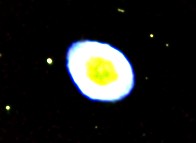 Having stacked the image I decided to crop it very close to the centre, and then played about more with the deconvolution settings in MaximDL. It brings out a little more detail and contrast in the (relatively) hot centre of the nebula, and the cooler outer regions, but as this is a raw single-shot colour based image with only a light pollution filter, not much detail of the nebula comes through. Can't wait to start using hydrogen-alpha and combining that data, but the telescope and camera are not suited to such small objects - the resolution falls off a cliff when zoomed in to this level. However, given the time of year, weather, and other limiting factors, I have had no choice but to image objects that are unsuitable for my set up. It is a good learning experience though...
Having stacked the image I decided to crop it very close to the centre, and then played about more with the deconvolution settings in MaximDL. It brings out a little more detail and contrast in the (relatively) hot centre of the nebula, and the cooler outer regions, but as this is a raw single-shot colour based image with only a light pollution filter, not much detail of the nebula comes through. Can't wait to start using hydrogen-alpha and combining that data, but the telescope and camera are not suited to such small objects - the resolution falls off a cliff when zoomed in to this level. However, given the time of year, weather, and other limiting factors, I have had no choice but to image objects that are unsuitable for my set up. It is a good learning experience though...For a much better idea of what I could be producing if someone gave me half a billion dollars, or a few hours with the HST, see here.

No comments:
Post a Comment